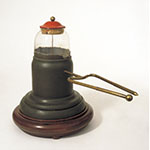This device was described by Benjamin Wilson in the Philosophical Transactions of the Royal Society in 1778 to demonstrate that the lightning conductor should end in a ball rather than a point.
The large Leyden jar, is placed in a wooden container and supported on a massive wooden base. From one side of the jar, in contact with its outer tin-foil coating, projects a brass fork-shaped conductor, one prong terminating in a sharp point, the other in a ball. The sleeves ending in a ball and a point could be moved toward a large brass ball on another support, until the discharge from the Leyden jar would strike either the ball, or the point, or both. According to Wilson, this experiment demonstrated that the point produced a spark three times as long as the ball conductor, and that therefore the lightning conductor ending in a ball was less dangerous. These experiments had a strong political connotation in England. Benjamin Franklin, who argued for the efficiency of point conductors, was also the leading statesman in the American colonies and thus disliked by King George III. Provenance: Lorraine collections.










